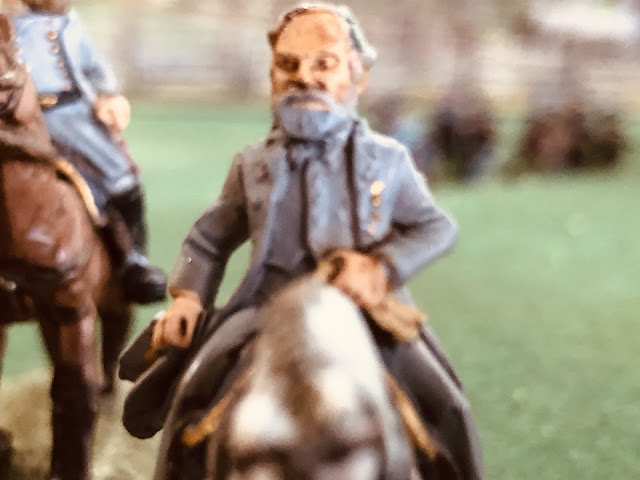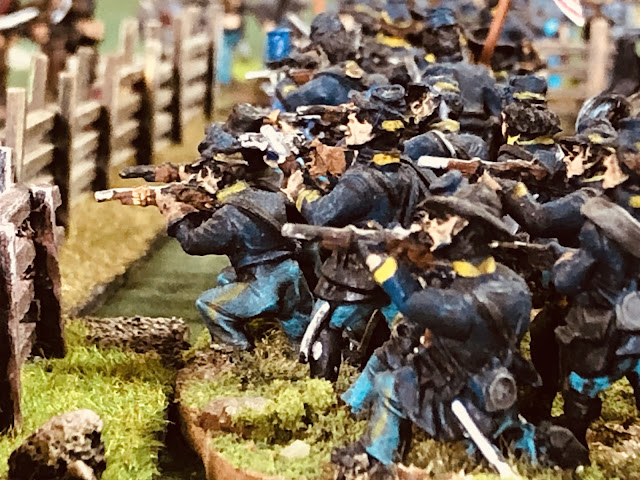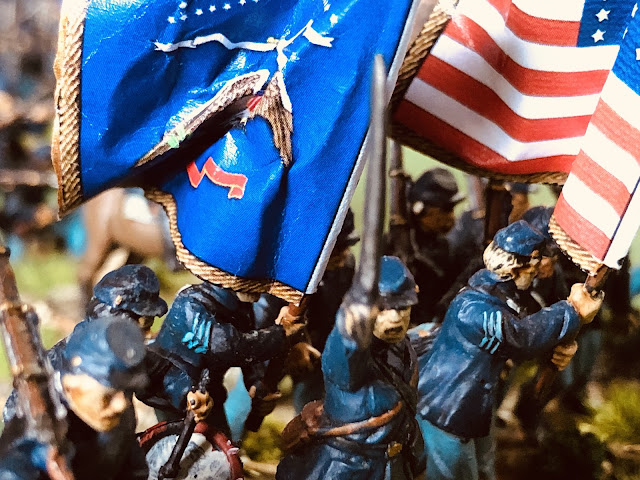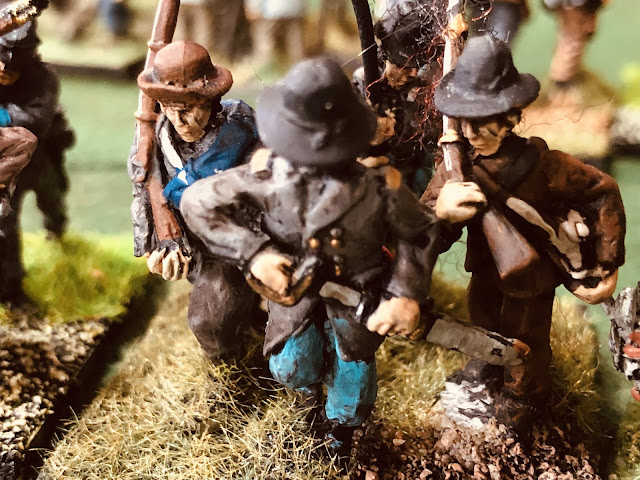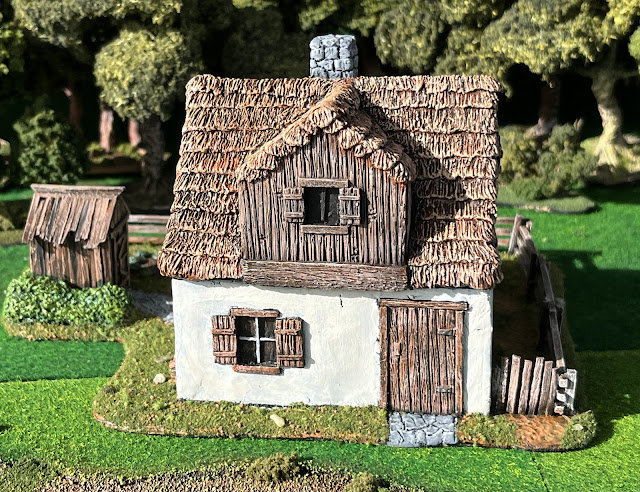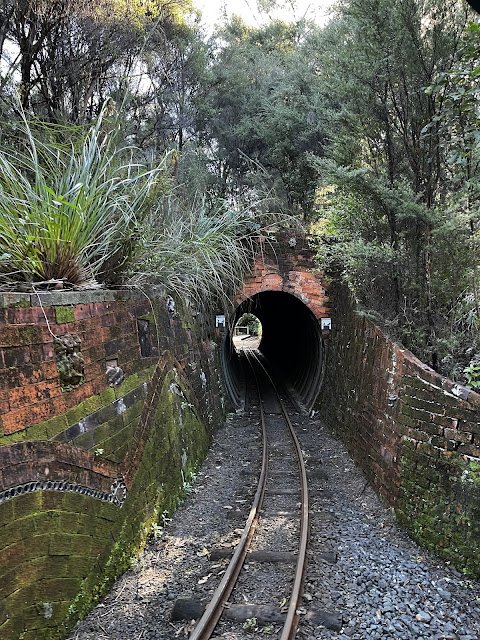A couple of years ago I read an account of the Appomattox Campaign and was attracted to the idea of a game where Sheridan's Cavalry Corps is trying to get ahead of the retreating Confederates to delay them enough for the infantry to catch up. Over time I began to develop an idea to refight the Battle of Sailor's Creek. The problem with this battle was fourfold. First, it was fought across quite a wide area. Second, the terrain was heavily wooded which always makes for an awkward game. Third, the number of units was large, albeit most of the Confederate units were very small, and while we had enough infantry units in our group collections, we had nowhere near enough the 40 or more cavalry units to create Sheridan's Corps. Fourth, a game set in 1865, with a Confederacy on life support, is a difficult one to enjoy if you are playing the Confederates.
So I decided to create a game based loosely around Sailor's Creek whereby a Union force consisting of a full cavalry division and two large infantry divisions have caught up with four very much under strength Confederate infantry divisions.
The Confederates start the game within their cantonments. Most of their units are tiny while some are small. Pickett's Division, for example, consisted of four brigades each of five tiny regiments. Their objective is to get as many units as possible across the creek and off the table. They will start with a total of 70 infantry units, twelve artillery batteries, four cavalry units and a wagon train - 90 units in total and this is their victory points total. For every infantry or cavalry unit they lose or fail to get across the creek and away they will deduct one point and for each artillery and supply unit lost two points. If at the conclusion of the game the still have 70 victory points they can count some success and the Army of Northern Virginia gets to fight another day. If they count 50 points or less the Army is irreparable damaged and surrender is likely in the next few days. Between 51 and 69 points means that the army has been mauled, but there is still a chance for continuing operations.
The Union objective is simple - do as much damage a possible to the enemy. The infantry enter the table edge marked Awhile the cavalry can enter either on the top edge or any three roads marked B, C or D, at B can occur in turn 1, at C on turn 3 or at D on turn 4 if a 1, 2 or 3 is rolled on a D6, otherwise on turn 5.
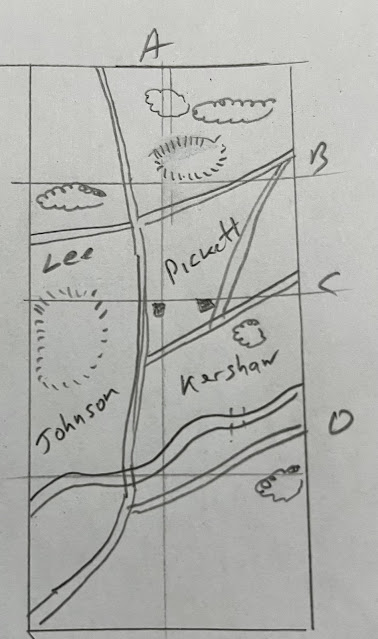 |
| A sketch of the table. The Confederate cantonments are marked by the name of the divisional commanders: Lee, Pickett, Johnson and Kershaw. |
A number of challenges face both armies. The ground is soft and artillery will move at half rates off road and can only cross the river at the bridge or the ford. Wagons can only cross at the bridge and there is a chance that they will stall on the bridge. Confederate artillery ammunition supply is low.
So the battle begins with alarm in the Confederate camps when Yankees are seen approaching. Two Union infantry divisions, a total of seven brigades and eight batteries appeared at A. One of Custer's brigades arrived at C shortly after. The Confederate brigades were called to arms and the supply train was set in motion.
GWC Lee's Division (RE Lee's eldest son) and Pickett's Division form quickly to face the threat while Kershaw guards the right flank and Johnson prepares to take position across the creek.
 |
| Lee quickly gathers his mainly raw regiments. |
 |
| The Union divisions surge foreward |
 |
| Pickett's Division forms up. |
 |
| Pickett repulses the first Union attack |
 |
| Fresh Union regiments press forward |
 |
| Meanwhile Lee's lead brigade takes position in the woods. They are engaged by the leading Union regiments, beginning a fight that would last most of the battle. |
Disaster struck early for the Confederates when the lead wagon stalled on the bridge, then when that cleared the second one stalled.
Custer brought on his second brigade at D and the third at C. He caused all sorts of confusion in Kershaw's ranks, capturing all four batteries of his artillery battalion, but could not establish a solid position and most of this troopers are driven off.
Pickett's Division was all but destroyed, although he managed to get his artillery battalion away, and Lee lost most of his first brigade, but managed to get some of his division away. Johnson's Division was only slightly engaged and managed to get his entire force across the creek, after the supply train finally cleared the bridge.
In the end the Confederates lost 39 victory points - one short of total disaster!
Now the images start to get out of sequence so I will just add them here randomly (most of these are provided by John, who played GWC Lee in the game).


